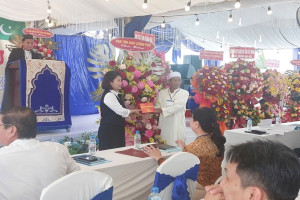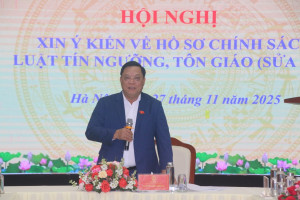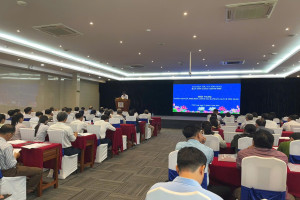
20 years after the Good Friday Agreement, few people recognize how Northern Ireland’s religious leaders helped bring peace
04/11/2018
Today marks the 20th anniversary of the Good Friday Agreement, the deal that brought an end to a 30-year bloody conflict in Northern Ireland, known as “The Troubles,” in which more than 3,000 people lost their lives. The agreement created a power-sharing assembly, hoping that would stabilize a divided society.
But for most people in Northern Ireland, the anniversary is cause more for concern than celebration. Right now, Northern Ireland has no functioning executive body. The Nationalists (predominantly Catholics) and the Unionists (predominantly Protestants) who fought during those years still live in separate and segregated communities. As Brexit looms, some fear conflict might return.
The conflict in Northern Ireland was mainly ethno-nationalist, with significant religious overtones — and those political tensions remain today. The Unionists want strong continued ties with England and are predominantly Protestant. The Nationalists want closer connections to the Republic of Ireland and are mainly Catholic.
Could religious leaders have done more to help bring peace and reconcile the two sides? I have met many scholars and policymakers who feel that they should have. Perhaps. And yet they did a great deal more than is generally understood. Last year I published a book based on interviews and archival research, showing that the leaders of the four main churches involved — the Presbyterian Church, Church of Ireland (Anglican), Methodist Church and Roman Catholic Church — did indeed work hard to bring peace to Northern Ireland, even when their institutions didn’t fully support those efforts.
Here are five ways Northern Irish religious leaders helped peacebuilding efforts during the Troubles.
1. They advised political leaders
The religious leaders recognized how serious tensions were early on. When the atrocities started in the 1960s, leaders from the Church of Ireland, Presbyterian Church and the Methodist Church wrote confidentially to British Prime Minister Harold Wilson to warn him about the increasing polarization.
As the conflict worsened, religious leaders wrote letters, held confidential meetings and conveyed insights to critical political actors behind the scenes. Gerry Adams, the leader of Sinn Fein (a major Nationalist party in Northern Ireland) between November 1983 and February 2018, writes in his memoir that Catholic priest Father Alec Reid helped shape Adams’s vision of what peace could be. Similarly, former Irish prime minister Albert Reynolds noted in his autobiography that Church of Ireland Archbishop Robin Eames helped him better understand the Protestant position and aspirations.
2. They offered practical recommendations
When the conflict started, the leaders of the four churches hesitated to offer insights on political matters. Then Ian Paisley, the fundamentalist evangelical leader of the Free Presbyterian Church and the Democratic Unionist Party, started to voice a virulently anti-Catholic stance. (Paisley moderated his messages later in the conflict, becoming a key figure in the peace process.) Mainstream religious leaders felt they had to counter Paisley’s extremist messages. In doing so, these religious leaders focused on what they regarded as the issues of common interest in the Northern Irish society, such as poverty alleviation and combating alcoholism.
Together and individually, religious leaders recommended a variety of efforts. In a 1989 address, Church of Ireland Archbishop Robin Eames suggested that Catholics and Protestants could work on less controversial issues like agriculture, health, tourism and regional development.
3. They encouraged a common identity
In public statements throughout the Troubles period, religious leaders from all four churches emphasized personal spiritual activities, such as family prayers, charity and forgiveness as part of a possible peace plan. Father Gerry Reynolds, a prominent Redemptorist priest known for his peacebuilding efforts, told me in an interview that as church leaders, they felt that they “just had to do everything to stop people getting killed, identify the causes, provide a better way, an alternative; to create communication between people from each sides, to keep the hope alive.”
Faith-based institutions like the Corrymeela Community and the Clonard Monastery kept helping Protestants and Catholics by providing a space for peace and reconciliation conversations. Together, religious leaders organized events of symbolic importance. In December 1986, for example, leaders of the four churches led 8,000 people in a walk for peace and unity.
4. They denounced violence …
Leaders of the four churches, individually and collectively, condemned the violent nationalism promoted by paramilitary groups on both sides. During the peace process, arsonists set fire to some church buildings, such as the 226-year-old Church of the Immaculate Conception in Mullavilly. Religious leaders of all four groups maintained unity and offered material assistance to churches that were attacked, regardless of denomination.
All four leaders even criticized politicians’ violent rhetoric. For example, in 1972, prominent unionist politician William Craig called on his side to “liquidate the enemy.” In response, Church of Ireland Bishop Arthur Butler said that “phrases like ‘the elimination’ and ‘liquidation of the enemies’ can never be in the vocabulary of the Christian who takes the New Testament as his guide.”
5. but they kept communication lines open
Religious leaders, often without support from their churches, met with a variety of political actors, including leaders of the paramilitaries. During the famous Feakle Talks of 1974, Protestant church leaders met with leaders of the Provisional Irish Republican Army.
Former Presbyterian Church leaders Jack Weir and Godfrey Brown, after talking with the Protestant paramilitary Ulster Defence Association, also met with Sinn Fein in 1992, at a time when other political parties ostracized both organizations.
In a similar vein, influential Presbyterian minister Rev. Roy Magee persuaded Loyalist militaries to lay down their arms in 1994, paving the way for peace talks. In fact, I’ve documented many instances of religious leaders communicating with paramilitaries when politicians did not dare to do so.
This history hasn’t been widely known. Since the peace agreement, religious leaders, together and individually, have been invited to conflict settings around the world to share what they learned. However, it still remains to be seen how they will navigate the challenges of a fragile peace. Church of Ireland Bishop of Connor, Alan Abernethy, warned me in 2008 that if bridges are not built, Northern Ireland might find itself in a worse situation than it faced during the Troubles.
Source: washingtonpost.com




